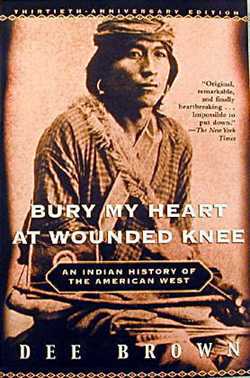

Bury My Heart's Bias Against Indians
By Rob Schmidt
The most notable thing in HBO's version of Dee Brown's Bury My Heart at Wounded Knee isn't the writing, acting, or directing. All these things are passable in this flawed but watchable movie. What stands out is the anti-Indian bias.
How is that possible in a production based on one of the most pro-Indian books ever? Read on for the evidence against the movie.
Bury My Heart's initial scene depicts Custer's attack against the Sioux encampment at Little Big Horn. But the most prominent hand-to-hand fights feature Indians battling Indians. One critic found this scene so confusing that he wasn't sure whether it was the Army or another tribe attacking the Sioux.
Presumably the Indian attackers were Custer's Indian scouts. But these scouts weren't key players in Custer's assault. I doubt they fought at all after scouting the enemy.
What's the effect of showing these Indian-on-Indian fights? It's to minimize the Army's role in instigating the attack. It makes it seem as if Indians were as much to blame as white men for attacking the Sioux.
After the battle, President Grant and Senator Henry Dawes discuss the outcome. Grant calls it a massacre, claiming the Indians didn't need to kill five regiments of troops. But unless I'm mistaken, Custer didn't try to surrender or retreat at Little Big Horn. The Indians kept fighting because Custer kept fighting, not because they were bloodthirsty savages who gloried in killing soldiers.
Grant and Dawes are measured voices of reason, yet they use the same language as the most vituperative editorials of the time. This establishes their anti-Indian position as the norm. Their point of view becomes the movie's point of view. The Indians brought about their fate because they massacred Custer's troops unfairly and unnecessarily.
Grant and Dawes also compare the Indians to welfare recipients, saying the reservation system has failed. This seems premature, as the system is too new to call it a failure already. The politicians—and by extension the producers—are editorializing about the state of the rez in the 21st century.
Grant and Dawes aren't blaming themselves for a policy they deem a failure. Instead, they're blaming the victims—implying the Indians are lazy bums. But who set up the reservation system and forced the Indians to accept it? They did, not the Indians.
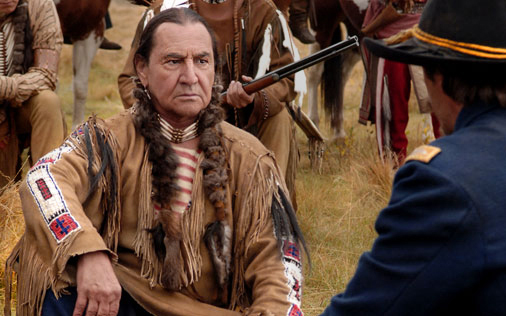
One massacre deserves another
Next comes Sitting Bull's exchange with Colonel Miles at Cedar Creek. I've commented on how this debate was probably invented. As I noted before, the parlay establishes the moral equivalence of the Americans and the Sioux. The Sioux invaded territories and killed people, so the US was justified in doing the same.
Producer Dick Wolf said this exchange is one passage he kept through all the drafts of the screenplay. It's clear he meant it as some sort of thematic statement. Everyone kills … it's just human nature … there's nothing to be done about it.
The key shortcoming in this exchange is treating the Sioux's incursion into the Plains as typical. The government persecuted a dozen Plains tribes besides the Sioux, many of whom were native to the area. Even if you buy that the Sioux were nasty and warlike, how does that apply to the other tribes? What's the justification for the war against Indians in the Southwest, California, and the Northwest?
Miles probably would answer the way many critics have answered: by claiming that most Indians were predatory before they met the Europeans. He seems to imply exactly that. But this assertion is a gross distortion of the facts. It ignores estimates that as many as 70% of the pre-Columbian tribes were peaceful.
Miles talks of half a dozen tribes the Sioux have exterminated. But the Sioux didn't exterminate the Pawnee, Kiowa, and others, since they're still here today. Not only does Miles make the Sioux seem warlike, he exaggerates how warlike they were.
With all his talk of equivalence, Miles says nothing about the real reasons the US attacked the Indians. Nothing about Manifest Destiny or the Americans' self-proclaimed right to the land. Nothing about how the lackadaisical Indians were wasting their resources when they could've been exploiting them instead.
These are the real reasons for the onslaught, but they go unvoiced in Bury My Heart. Wolf and company would have you believe it's the nature of the strong to conquer the weak. In their "survival of the fittest" scenario, the victims get what they deserve.
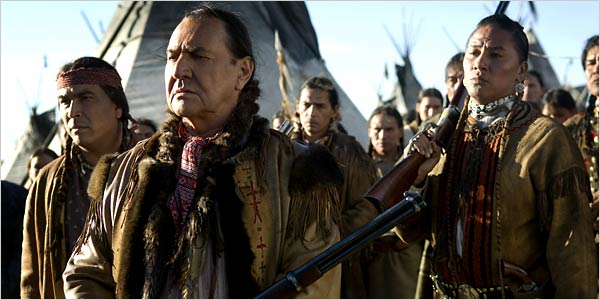
Sitting Bull brought down
Bury My Heart's three main characters also show an anti-Indian bias. Dawes is calm, self-assured, almost noble in his quest to save the Indians. He never wavers and is never seriously challenged by others.
In contrast, Sitting Bull comes across as angry, venal, and hypocritical. He's constantly challenged about his views—by Colonel Miles, by his followers, and by Indian agent McLaughlin. McLaughlin accuses him of wanting to be the biggest chief and have the biggest house. He ridicules Sitting Bull for signing autographs and performing for money.
This is a complex portrayal of Sitting Bull. It may well be an accurate one. But only the Indian is subjected to such scrutiny. Nobody confronts or criticizes Grant, Dawes, Miles, or McLaughlin. Their motives and flaws go unexamined.
As another example, McLaughlin calls Sitting Bull a liar for saying he shook hands with President Grover Cleveland. But most sources say the meeting took place:
The troupe of nine American Indians, counting Sitting Bull, had two interpreters. Their group traveled together from September 2, 1884 until October 25th. They visited twenty-five (25) cities, from Minneapolis to New York. Sitting Bull met President Grover Cleveland in 1885.
So Bury My Heart repeatedly undercuts the credibility of Sitting Bull and only Sitting Bull. It mocks him for trying to follow the white man's ways. It calls him a liar when he wasn't one.
Sitting Bull was a revered spiritual leader, but you don't see much of his spirituality or his leadership. Instead, the movie makes him out to be a vain politician. Not only does it bring him down to the level of the others, it brings him lower. The movie's white men seem more honest and principled than he does.
The role of the other Sioux in Bury My Heart is probably significant. Red Cloud looks like a weak appeaser because he signs away his freedom. But Crazy Horse, the uncompromising foe of conciliation, isn't shown. Portraying him would've demonstrated that not all the Indians accepted their fate.
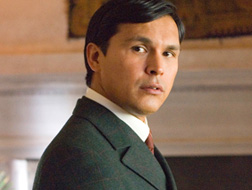
The end of Eastman's trail
As the critics noted, Charles Eastman's role in the story is largely made up. It's also unnecessary. The story would've worked well enough if various Indians spoke for themselves. As one critic observed, Roots was a blockbuster without a white point of view, so Bury My Heart could've been also.
Using Eastman implies the creators couldn't find any real Indian champions. In other words, that Indians weren't well-versed enough to make their own case. The only one who could speak for them was a fictional version of Eastman.
Moreover, the movie's Eastman comes across as naive and gullible. He has little or no idea what's happening to his people until it's too late. When he finally realizes the truth, according to Bury My Heart, it shatters him.
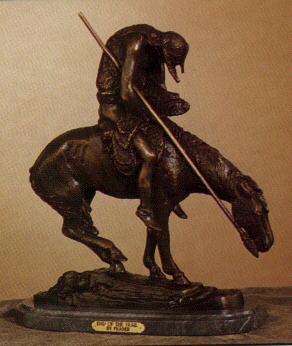
"This is a character who came full circle in his life, and yet the great tragedy of this man is that he never found a true home in his own soul between his Native American culture and the white culture. Ultimately, he felt tremendously betrayed by the whites. And the massacre at Wounded Knee totally, totally broke this man."
In the end, the movie's Eastman fails at various jobs and has to go to Dawes for help. Dawes gives him the job of choosing Christian names for the Sioux—a task about as demeaning as they come. Eastman kicks the boxes of forms in frustration.
So Eastman, our stand-in for progressive Indians, can't cope with the modern world. If the most successful Indian of his time had to give up, what chance did traditional Indians have? None, apparently; neither assimilation nor resistance could save them.
In effect, Eastman becomes a living "End of the Trail" statue. He voices and represents the tragic downfall of the Indian. He shows us that Indians were doomed to die as their age-old way of life ended.
In reality, this is a fabrication of Eastman's life. He wasn't shattered by his experiences; he led a long and productive life as an advocate for Indians. According to Wikipedia:
Eastman worked as agency physician for the Indian Health Service on the Pine Ridge Reservation, and later at the Crow Creek Reservation, both in South Dakota. He also established a private medical practice. Between 1894-97, Eastman established 32 Indian groups of the Young Men's Christian Association (YMCA). In 1899, he helped recruit students for the Carlisle Indian School in Pennsylvania. In 1910, along with Ernest Thompson Seton of the Woodcraft Indians and Daniel Carter Beard of the Sons of Daniel Boone, Eastman helped found the Boy Scouts of America.
Eastman was active in politics, particularly in matters dealing with Indian rights. He served as a lobbyist for the Dakota between 1894 and 1897. In 1903, President Theodore Roosevelt assigned Eastman the responsibility for revising the allotment method of dividing tribal lands. In 1923-25, Eastman served under Calvin Coolidge as an Indian inspector. He was also a member of the Committee of One Hundred, a reform panel examining federal institutions and activities dealing with Indian nations. In 1925, the Bureau of Indian Affairs asked him to investigate the death and burial location of Sacagawea, the woman who accompanied the Lewis and Clark Expedition in 1805.
But Bury My Heart gives no hint of these activities. Portraying Eastman as a success rather than a failure would've undercut its anti-Indian message. We'd see that Indians weren't doomed because of the nature of things—that they could succeed and flourish if given half a chance.
The moviemakers didn't insert Eastman because they needed a white point of view. They inserted him because they needed a tragic, shattered point of view. They needed someone to convey their ideological belief that the Indians were losers.
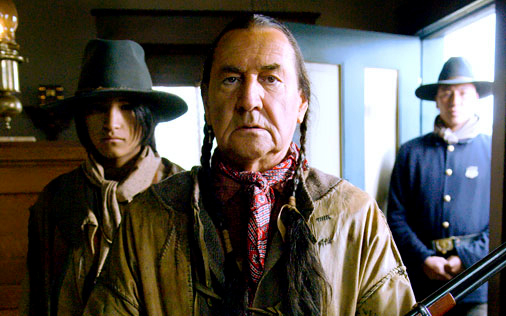
Deaths a tragic mistake
Finally, consider the deaths of Sitting Bull and the Sioux at Wounded Knee. Bury My Heart's has twisted each to fit its anti-Indian theme.
Some historians have called the killing of Sitting Bull a political assassination. At a minimum they've said he was killed intentionally. For instance:
By this time [Sitting Bull] was fully dressed, and the policemen took him out of the house; but, upon getting outside, they found themselves completely surrounded by Sitting Bull's followers, all armed and excited. The policemen reasoned with the crowd, gradually forcing them back, thus increasing the open circle considerably; but Sitting Bull kept calling upon his followers to rescue him from the police; that if the two principal men, "Bull Head" and "Shave Head," were killed the others would run away, and he finally called out for them to commence the attack, whereupon "Catch the Bear" and "Strike the Kettle," two of Sitting Bull's men, dashed through the crowd and fired. Lieut. "Bull Head" was standing on one side of Sitting Bull and 1st Sergt. "Shave Head" on the other, with 2d Sergt. "Red Tomahawk" behind, to prevent his escaping; "Catch the Bear's " shot struck Bull Head in the right side, and he instantly wheeled and shot Sitting Bull, hitting him in the left side, between the tenth and eleventh ribs, and "Strike the Kettle's" shot having passed through Shave Head's abdomen, all three fell together.
But in Bury My Heart, Sgt. "Bull Head" shoots Sitting Bull inadvertently after he himself is shot. So there's no plot against Sitting Bull, no wish to see him dead. It's all a big mistake.
The pro-American, anti-Indian bias reaches its culmination at Wounded Knee. Historical reports differ on who fired the first shot there. But in Bury My Heart, an Indian clearly shoots first. A soldier reiterates this after the fact, swearing the American troops didn't start the conflagration.
So Wounded Knee is less a massacre than a tragic mistake. The soldiers didn't intend to hurt anyone; they fired only in self-defense. Again, it's just the nature of things: people get hurt in times of war. Neither side is to blame.
Conclusion
The producers have implied they didn't want to make an anti-government movie. It would've been too negative, too hard to sell. Instead they watered down Dee Brown's book to make it palatable to viewers. That may have been a marketable choice, but it sure wasn't a moral one.
Wolf and company have said all the right things in published interviews. They may not even be aware that they softened Brown's emphasis. But a lack of conscious intent doesn't change the results. HBO's movie is prejudiced against Indians.
To recap: According to Bury My Heart, the Indians massacred the soldiers at Little Big Horn. The Army was merely emulating the tactics of the Sioux before them. Dawes had a noble plan to save the Indians. Sitting Bull cared more about his perks than his people. Modern life was too much for Indians such as Eastman to handle. The deaths of Sitting Bull and the Sioux at Wounded Knee were unfortunate mistakes.
If that isn't an anti-Indian bias, I'm not sure what is. Bury My Heart takes a clear case of wrongdoing and muddles it. In this version of history, there are no good or bad guys. Flawed Americans, flawed Indians ... they're all the same.
More on Bury My Heart
A roundup of postings on HBO's Bury My Heart at Wounded Knee:
Related links
TV shows featuring Indians
The best Indian movies
The best Indian books
|
. . . |

|
All material © copyright its original owners, except where noted.
Original text and pictures © copyright 2007 by Robert Schmidt.
Copyrighted material is posted under the Fair Use provision of the Copyright Act,
which allows copying for nonprofit educational uses including criticism and commentary.
Comments sent to the publisher become the property of Blue Corn Comics
and may be used in other postings without permission.